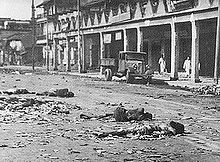Riots in Calcutta in 1946
The riots in Calcutta from 1946 , in English as "Great Calcutta Killing" or "Direct Action Day" called, took place between 16 and 19 August 1946.
Violent clashes broke out in Kolkata between Muslims and Hindus , in which it is estimated that between 5,000 and 10,000 people were killed and another 15,000 were injured. The unrest contributed to the fact that leading politicians of the Indian National Congress came to the opinion that the division of India into a Muslim state Pakistan and a Hindu state India, called for by the Muslim League , would be the better or only possible solution to the conflict. The Indian National Congress had previously always insisted on the unity of India after the end of British colonial rule.
The unrest was triggered by a general strike called "Direct Action Day 1946" by the Muslim League .
background
The Muslim League and the Indian National Congress were the two most influential parties in the Constituent Assembly of India during the 1940s. While the Muslim League was purely Muslim , Hindus formed the majority in the Indian National Congress . But in contrast to the Muslim League, the Indian National Congress advocated a policy of Indian unity and rejected Muhammad Ali Jinnah's concept of establishing a purely Muslim state within India. In 1946 a British Parliamentary Commission (1946 Cabinet Mission to India) published its proposals for the transfer of power from British colonial rule to the Indians. These were based on a new independent " Dominion " India, which should consist of federal states within a common union of India. Ali Jinnah rejected this concept on behalf of the Muslim League and continued to insist on a separate, purely Muslim new state of Pakistan. However, this request was rejected by the Indian National Congress.
In order to reinforce the demand for a Muslim state of its own and to protest against its rejection by the Indian National Congress, the Muslim League called for a general strike on August 16, 1946, a so-called Hartal . At that time, the province of Bengal was populated by a Muslim majority and was the only province in British India to be ruled by a Muslim League provincial government. In Calcutta, however, Hindus formed a clear majority of the population.
The unrest is spreading
Against this background, the strike announced by the Muslim League sparked massive violent unrest between Hindus and Muslims. It is controversial which part of the population started the first acts of violence, as there are reports of attacks by Muslims on Hindu shops as well as those of angry Hindus who attacked Muslims with so-called lathis (batons) around the same time.
Within 72 hours, over 5,000 people lost their lives in Calcutta and the surrounding area, while another 100,000 people became homeless. Other sources even assume 7,000-10,000 fatalities. The distribution of victims between the various religions is also controversial . While some evidence suggests that the number of Hindu victims was higher, others suggest a majority of Muslim victims.
Affected by the unrest and the number of victims, Mahatma Gandhi went to the region to call for peace and reconciliation.
However, in the wake of the outbreak of violence, Jinnah moved away from the idea of a separate Muslim state within a federal India. He now insisted all the more firmly on the establishment of a sovereign nation of Pakistan after the end of British colonial rule.
The violence in Calcutta initially led to a flood of refugees from the city, in the following days to more riots in Noakhali , Bihar , now Uttar Pradesh , the Punjab and the North West Frontier Province , and eventually to the partition of India , which also has a second partition of Bengal after the division from 1905–1911 brought.
See also
literature
- Collins, Larry and Dominique Lapierre: Gandhi. Freedom at midnight 1975. ISBN 978-3442067596
- Patrick French Liberty or Death , Harper Collins, 1997
- Louis Fischer Life of Mahatma Gandhi Harper Collins, 2007
- Geoffrey Moorhouse Calcutta Littlehampton, 1971
Individual evidence
- ^ Markovits Claude: The Calcutta Riots of 1946, Mass Violence & Résistance . Ed .: Science Po . November 5, 2007, ISSN 1961-9898 (English, online ).
- ↑ a b Panigrahi, DN (2004). India's Partition: The Story of Imperialism in Retreat. Routledge, page: 294-296
- ^ A b Stanley Wolpert Jinnah of Pakistan Oxford University Press, 1984, ISBN 0195034120 .
- ↑ Tsugitaka, Sato Muslim Societies: Historical and Comparative Aspects Routledge, 2000, p. 112.
- ^ Ayesha Jalal The Sole Spokesman: Jinnah, the Muslim League and the Demand for Pakistan . Cambridge University Press., 1994, ISBN 0521458501
- ^ Claude Markovits (2011): The Calcutta Riots of 1946 , Online Encyclopedia of Mass Violence, available online as html ; last accessed on August 28, 2011
- ^ John Keay India: A history , Grove Press, 2000, pp. 503-507
- ↑ Suranjan Das Communal Riots in Bengal, 1905-1947 Oxford University Press, 1991 ISBN 0195628403 .
